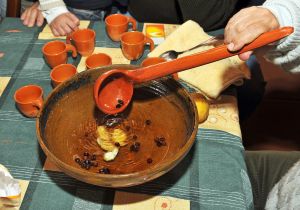The Spirits of Galicia
November 11, 2016 1 Comment
If you visit Galicia (and you really should), you’ll probably want to stay in Santiago de Compostela. While you are there, you can backtrack along the final kilometers of the Camino de Santiago, and feel the amazement as the Cathedral—the final spot for so many who have traveled so far—comes into view.
You’ll definitely want to attend the mid-day Pilgrim’s Mass (where hopefully they will swing the botafumeiro—a gigantic incense burner, from the ceiling). After Mass, you might want to visit the Museum of the Galician People and the Galicia Contemporary Art Centre.
For dinner, wander around the old town and take your pick of the tapas bars. Be sure and sample the Caldo Galego, a traditional soup of potatoes, cabbage, and ham; and the Empanadas Galegas, which are typically baked into a large pie and cut into wedges. Treats for seafood lovers abound, but a plate of Pulpo Galego a la Ferira (octopus cooked whole and cut into bite-sized pieces) is the local favorite.
The next day, try to wake up early and take the train to Pontevedra. Once there, you’ll be in the heart of the Rías Baixas wine region and can easily visit several wineries with just a short drive, including my favorites Bodegas Martín Códax, Mar de Frades, and Bodegas Paco & Lola (where they make the famous “Polka Dot” Albariño).
One more thing: don’t miss out on the unique spirits of Galicia, most of which are based on the left-overs (pomace) of the outstanding wine production in the area. The pomace brandy of the area is known Orujo. Orujo (named after the Spanish word for pomace) is actually produced all over Spain, but has a special significance in the north of Spain.
Orujo de Galicia PGI: A regional version of orujo—Orujo de Galicia, produced in almost all of the wine areas of Galicia—has been awarded PGI status. Production methods for Orujo de Galicia vary, but the use of copper pot stills is traditional. Orujo, similar to Italy’s famous and popular grappa, may be produced in households, but there are over 85 commercial producers of the spirit.
Like most pomace brandies, Orujo is typically made as a somewhat fiery, raw, and unaged spirit. However, an aged version, known as Orujo envejecido (aged Orujo), is oak-aged for at least one year in barrels of 500-liter capacity or smaller (or two years in larger barrels).
Three other PGI spirits—Aguardiente de Hierbas de Galicia, Licor Café de Galicia, and Licor de Hierbas de Galicia—are also produced in the area.
Aguardiente de Hierbas de Galicia PGI: de Hierbas de Galicia PGI is a flavored spirit produced using Orujo de Galicia as the base spirit. It is created by soaking (macerating) a variety of herbs in the Orujo, by the re-distillation of the Orujo in the presence of herbs, or a combination of these procedures. According to the PGI regulations, Aguardiente de Hierbas de Galicia PGI must be produced using at least three different herbs or botanicals. Any herbs that are suitable for food may be used, but peppermint, chamomile, lemon verbena, rosemary, oregano, thyme, coriander, saffron, orange blossom, fennel, licorice, walnut, nutmeg and cinnamon are among the most widely used. Aguardiente de Hierbas de Galicia PGI usually has a clear, light-green color and must have no more than 100 g/L of sugar.
Licor de Hierbas de Galicia PGI: Licor de hierbas de Galicia is produced using a base of Orujo de Galicia, although neutral spirits are allowed as well. It must be bottled at a minimum of 20% abv and contain at least 100 g/L of sugar (making it technically a liqueur). The color ranges from straw yellow to light yellow-green. Licor de hierbas de Galicia must be flavored using at least three types of herbs, although many versions contain a dozen or more more.
Licor Café de Galicia PGI: Café de Galicia PGI is produced using Orujo de Galicia as its spirit base, but neutral spirits are also allowed. This is a sweetened spirit (liqueur) flavored with roasted coffee beans. Licor Café de Galicia may be produced via maceration, re-distillation, or a combination of methods, and must contain a minimum of 100 g/L of sugar.
When in Galicia: In addition to being served straight, on the rocks, or in a variety of cocktails, Orujo de Galicia is used in a regional beverage known as queimada. Queimada is made with orujo, sugar, lemon peel, cinnamon, and coffee beans. The ingredients are poured into a clay pot, set aflame, stirred until the blue flames die out, then ladled into ceramic cups. The sharing of queimada is accompanied by the recitation of an incantation (which is often described as a “spell” of protection against witches and things that go bump in the night). The sharing of the queimada is based on Celtic lore and considered a part of Galician tradition.
References/for more information:
- http://www.orujodegalicia.org/index.php
- http://pacolola.com/en/bodega
- http://www.martincodax.com/en/
- http://www.mardefrades.es/en/
- Technical File Orujo de Galicia PGI
- Technical File Aguardiente de Hierbas de Galicia PGI
- Technical File Licor de Hierbas de Galicia PGI
- Technical File Licor de Cafe de Galicia PGI
The Bubbly Professor is “Miss Jane” Nickles of Austin, Texas… missjane@prodigy.net




Pingback: Spaced Repetition: Conquer the Curve of Forgetting | The Bubbly Professor